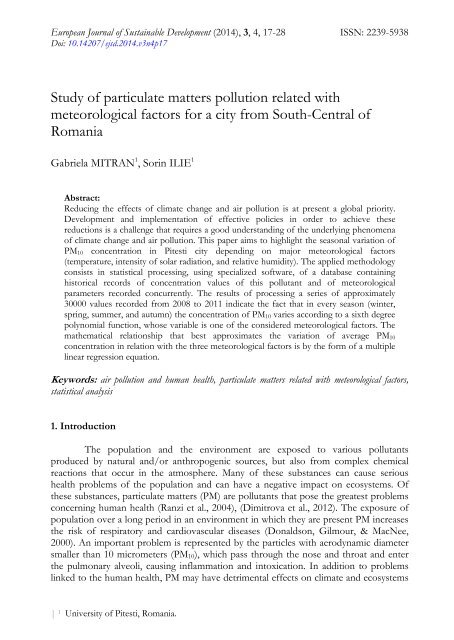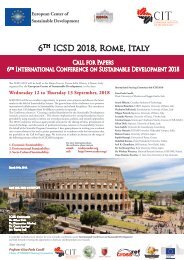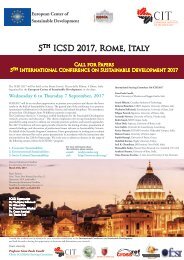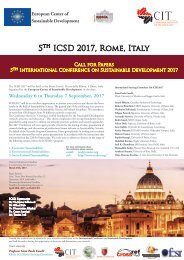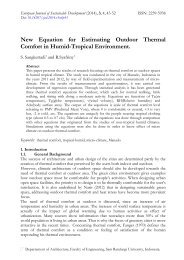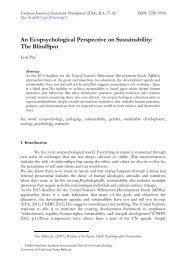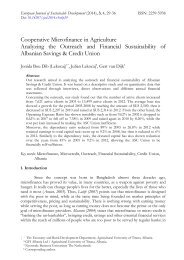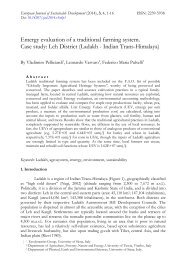Study of particulate matters pollution related with meteorological factors for a city from South-Central of Romania
Reducing the effects of climate change and air pollution is at present a global priority. Development and implementation of effective policies in order to achieve these reductions is a challenge that requires a good understanding of the underlying phenomena of climate change and air pollution. This paper aims to highlight the seasonal variation of PM10 concentration in Pitesti city depending on major meteorological factors (temperature, intensity of solar radiation, and relative humidity). The applied methodology consists in statistical processing, using specialized software, of a database containing historical records of concentration values of this pollutant and of meteorological parameters recorded concurrently. The results of processing a series of approximately 30000 values recorded from 2008 to 2011 indicate the fact that in every season (winter,spring, summer, and autumn) the concentration of PM10 varies according to a sixth degree polynomial function, whose variable is one of the considered meteorological factors. The mathematical relationship that best approximates the variation of average PM10 concentration in relation with the three meteorological factors is by the form of a multiple linear regression equation. Keywords: air pollution and human health, particulate matters related with meteorological factors, statistical analysis
Reducing the effects of climate change and air pollution is at present a global priority. Development and implementation of effective policies in order to achieve these reductions is a challenge that requires a good understanding of the underlying phenomena of climate change and air pollution. This paper aims to highlight the seasonal variation of PM10 concentration in Pitesti city depending on major meteorological factors (temperature, intensity of solar radiation, and relative humidity). The applied methodology consists in statistical processing, using specialized software, of a database containing historical records of concentration values of this pollutant and of meteorological parameters recorded concurrently. The results of processing a series of approximately 30000 values recorded from 2008 to 2011 indicate the fact that in every season (winter,spring, summer, and autumn) the concentration of PM10 varies according to a sixth degree polynomial function, whose variable is one of the considered meteorological factors. The mathematical relationship that best approximates the variation of average PM10 concentration in relation with the three meteorological factors is by the form of a multiple linear regression equation.
Keywords: air pollution and human health, particulate matters related with meteorological factors, statistical analysis
Create successful ePaper yourself
Turn your PDF publications into a flip-book with our unique Google optimized e-Paper software.
European Journal <strong>of</strong> Sustainable Development (2014), 3, 4, 17-28 ISSN: 2239-5938<br />
Doi: 10.14207/ejsd.2014.v3n4p17<br />
<strong>Study</strong> <strong>of</strong> <strong>particulate</strong> <strong>matters</strong> <strong>pollution</strong> <strong>related</strong> <strong>with</strong><br />
<strong>meteorological</strong> <strong>factors</strong> <strong>for</strong> a <strong>city</strong> <strong>from</strong> <strong>South</strong>-<strong>Central</strong> <strong>of</strong><br />
<strong>Romania</strong><br />
Gabriela MITRAN 1 , Sorin ILIE 1<br />
Abstract:<br />
Reducing the effects <strong>of</strong> climate change and air <strong>pollution</strong> is at present a global priority.<br />
Development and implementation <strong>of</strong> effective policies in order to achieve these<br />
reductions is a challenge that requires a good understanding <strong>of</strong> the underlying phenomena<br />
<strong>of</strong> climate change and air <strong>pollution</strong>. This paper aims to highlight the seasonal variation <strong>of</strong><br />
PM 10 concentration in Pitesti <strong>city</strong> depending on major <strong>meteorological</strong> <strong>factors</strong><br />
(temperature, intensity <strong>of</strong> solar radiation, and relative humidity). The applied methodology<br />
consists in statistical processing, using specialized s<strong>of</strong>tware, <strong>of</strong> a database containing<br />
historical records <strong>of</strong> concentration values <strong>of</strong> this pollutant and <strong>of</strong> <strong>meteorological</strong><br />
parameters recorded concurrently. The results <strong>of</strong> processing a series <strong>of</strong> approximately<br />
30000 values recorded <strong>from</strong> 2008 to 2011 indicate the fact that in every season (winter,<br />
spring, summer, and autumn) the concentration <strong>of</strong> PM 10 varies according to a sixth degree<br />
polynomial function, whose variable is one <strong>of</strong> the considered <strong>meteorological</strong> <strong>factors</strong>. The<br />
mathematical relationship that best approximates the variation <strong>of</strong> average PM 10<br />
concentration in relation <strong>with</strong> the three <strong>meteorological</strong> <strong>factors</strong> is by the <strong>for</strong>m <strong>of</strong> a multiple<br />
linear regression equation.<br />
Keywords: air <strong>pollution</strong> and human health, <strong>particulate</strong> <strong>matters</strong> <strong>related</strong> <strong>with</strong> <strong>meteorological</strong> <strong>factors</strong>,<br />
statistical analysis<br />
1. Introduction<br />
The population and the environment are exposed to various pollutants<br />
produced by natural and/or anthropogenic sources, but also <strong>from</strong> complex chemical<br />
reactions that occur in the atmosphere. Many <strong>of</strong> these substances can cause serious<br />
health problems <strong>of</strong> the population and can have a negative impact on ecosystems. Of<br />
these substances, <strong>particulate</strong> <strong>matters</strong> (PM) are pollutants that pose the greatest problems<br />
concerning human health (Ranzi et al., 2004), (Dimitrova et al., 2012). The exposure <strong>of</strong><br />
population over a long period in an environment in which they are present PM increases<br />
the risk <strong>of</strong> respiratory and cardiovascular diseases (Donaldson, Gilmour, & MacNee,<br />
2000). An important problem is represented by the particles <strong>with</strong> aerodynamic diameter<br />
smaller than 10 micrometers (PM 10 ), which pass through the nose and throat and enter<br />
the pulmonary alveoli, causing inflammation and intoxication. In addition to problems<br />
linked to the human health, PM may have detrimental effects on climate and ecosystems<br />
| 1 University <strong>of</strong> Pitesti, <strong>Romania</strong>.
18 European Journal <strong>of</strong> Sustainable Development (2014), 3, 4, 17-28<br />
(Carnevale, Pisoni, & Volta, 2008). Particulate <strong>matters</strong> are inhalable particles, harmful to<br />
human health and to environment aesthetics, which spread locally and regionally (under<br />
the action <strong>of</strong> atmospheric transport). At the level <strong>of</strong> European Union Member States, in<br />
2010, the major producing sources <strong>of</strong> PM 10 were the commercial activities and fuel<br />
consumption in households (41%), transports (17%) and industrial processes (15%)<br />
(European Environment Agency, 2012). The concentration <strong>of</strong> PM 10 in the atmosphere is<br />
closely cor<strong>related</strong> <strong>with</strong> <strong>meteorological</strong> parameters in the frame <strong>of</strong> dispersion processes<br />
and the atmospheric transport. Further, in this work the authors highlighted the<br />
variations in quantity <strong>of</strong> PM 10 , both relative to each <strong>of</strong> the <strong>meteorological</strong> parameters<br />
(temperature, intensity <strong>of</strong> solar radiation, and relative humidity), and relative to all these<br />
parameters, in the same time, corresponding to the urban environment <strong>of</strong> Pitesti, a<br />
medium sized <strong>city</strong> in <strong>Romania</strong>. The variation functions in relation to the independent<br />
variables above mentioned are determined using numerical programs specialized in<br />
analysis and statistical processing <strong>of</strong> data.<br />
2. Framework<br />
The <strong>city</strong> <strong>of</strong> Pitesti, the residence <strong>of</strong> Arges county, is located in the south-central<br />
part <strong>of</strong> <strong>Romania</strong>, between the Carpathians mountains and the Danube river, at the<br />
confluence <strong>of</strong> Arges and Doamnei rivers, in the intersection point <strong>of</strong> the parallel <strong>of</strong><br />
44°51'30 north latitude <strong>with</strong> the meridian <strong>of</strong> 24°52' east longitude, at approximately equal<br />
distance <strong>from</strong> the North Pole and the Equator, the parallel <strong>of</strong> 45° crossing at a distance<br />
<strong>of</strong> 20 km <strong>from</strong> Pitesti. The <strong>city</strong> is located at altitudes between 252 m (in the <strong>South</strong>) and<br />
356 m (in the North-West). The vicinities <strong>of</strong> the <strong>city</strong> rises at levels <strong>of</strong> 373 m - in West<br />
zone, 406 m - in East zone and 439 m - in North-West zone, which means the locality is<br />
in a depressionary area. The climate is temperate continental <strong>for</strong>est type, hilly floor. The<br />
<strong>city</strong> itself, located between the piedmont high hills, on the terraces <strong>of</strong> Arges river, has a<br />
topo-climate <strong>of</strong> a valley, prevailing calm, moderate weather. In the winter months are not<br />
recorded very low temperatures or strong storms and summers are less hot. The<br />
multiannual average temperature is 9.7 °C, the absolute maximum temperature is 38.8<br />
°C, and the absolute minimum temperature is -24.4 °C. The total amount <strong>of</strong> annual<br />
precipitations is 663.3 mm. The air circulation is produced mostly <strong>from</strong> the North-East<br />
(26%), and then <strong>from</strong> North (14%), West (12%) and East (11%). The atmospheric calm<br />
has a frequency <strong>of</strong> 15%. The average yearly speed is 2.6 m/s, ranging <strong>from</strong> 0.9 m/s <strong>from</strong><br />
<strong>South</strong>-West in December, to 4.7 m/s <strong>from</strong> East in March. The atmospheric humidity is,<br />
on average, <strong>of</strong> 68%.<br />
3. Methodology<br />
3.1. Experimental data<br />
Starting <strong>with</strong> 2008 in <strong>Romania</strong> operates National Network <strong>for</strong> Air Quality<br />
Monitoring, consisting <strong>of</strong> 41 local centers in which are located 142 stations <strong>for</strong><br />
continuously monitoring air quality, endowed <strong>with</strong> automatic equipments <strong>for</strong><br />
measurement the concentrations <strong>of</strong> the main air pollutants. These stations are grouped<br />
into six categories according to the main <strong>pollution</strong> <strong>factors</strong> in their area <strong>of</strong> influence, as<br />
Published by ECSDEV, Via dei Fiori, 34, 00172, Rome, Italy<br />
http://ecsdev.org
G. Mitran, S. Ilie 19<br />
following: (1) traffic type stations, (2) industrial type stations, (3) urban background type<br />
stations, (4) suburban background type stations, (5) regional background type stations<br />
and (6) EMEP (European Monitoring and Evaluation Programme) type stations, <strong>for</strong><br />
monitoring and evaluation <strong>of</strong> air <strong>pollution</strong> in long distance trans-boundary context<br />
(Ministry <strong>of</strong> Environment and Forests, 2012). In the <strong>city</strong> <strong>of</strong> Pitesti are operating two air<br />
quality monitoring stations: station AG1 (<strong>of</strong> traffic type, whose representativeness radius<br />
is between 10 m and 100 m; the monitored pollutants are: NO, NO 2 , NO x , SO 2 , CO,<br />
PM 10 , BTEX, Pb, Cd, Ni, As) and station AG2 (<strong>of</strong> urban background type, whose<br />
representativeness radius is between 1 km and 5 km; the monitored pollutants are: NO,<br />
NO 2 , NO x , SO 2 , CO, O 3 , PM 10 , BTEX). Station AG2 is centrally located in the <strong>city</strong>,<br />
<strong>with</strong>in the pedestrian area and, in addition to station AG1, it monitors also the<br />
<strong>meteorological</strong> parameters (direction and speed <strong>of</strong> wind, pressure, temperature, intensity<br />
<strong>of</strong> solar radiation, relative humidity, the amount <strong>of</strong> precipitations).<br />
3.2. Analysis method<br />
The variation <strong>of</strong> PM 10 amount associated to urban background in Pitesti municipality,<br />
generated by stationary producing pollutants sources, as well as by mobile sources, in<br />
relation to the <strong>meteorological</strong> parameters - temperature, intensity <strong>of</strong> solar radiation, and<br />
relative humidity - was studied using logical scheme presented in Figure 1.<br />
Figure 1. Logical scheme <strong>for</strong> studying the dependence <strong>of</strong> PM 10 on <strong>meteorological</strong> parameters.<br />
© 2014 The Authors. Journal Compilation © 2014 European Center <strong>of</strong> Sustainable Development.
20 European Journal <strong>of</strong> Sustainable Development (2014), 3, 4, 17-28<br />
In this work we used a set <strong>of</strong> approximately 30000 valid entries <strong>for</strong> the values <strong>of</strong> PM 10<br />
emission factor and <strong>for</strong> the following <strong>meteorological</strong> parameters: temperature, intensity<br />
<strong>of</strong> solar radiation, and relative humidity, recorded at intervals <strong>of</strong> one hour, in the air<br />
quality monitoring station AG2, located in the <strong>city</strong> centre. For each <strong>of</strong> the monitored<br />
parameters (<strong>of</strong> <strong>pollution</strong> and <strong>of</strong> weather), we computed the hourly average values<br />
specific to the four seasons: winter, spring, summer, and autumn. The database that<br />
contains the data, <strong>from</strong> the two monitoring air quality fixed stations, recorded in the<br />
period January 2008 to December 2011 were obtained <strong>from</strong> Regional Environmental<br />
Protection Agency Pitesti based on a protocol agreed between this institution and<br />
University <strong>of</strong> Pitesti.<br />
Statistical processing <strong>of</strong> the four sets <strong>of</strong> values was per<strong>for</strong>med <strong>with</strong> TableCurve 2D<br />
s<strong>of</strong>tware, which allows the identification <strong>of</strong> a set <strong>of</strong> several hundreds <strong>of</strong> mathematical<br />
variation functions <strong>for</strong> each relationship examined, indicating both their mathematical<br />
expressions and graphical representations in the coordinate system xOy. Also, <strong>for</strong> each<br />
<strong>of</strong> the identified mathematical functions, it provides the coefficient <strong>of</strong> determination r 2 ,<br />
which helps to identify the best analytical expressions that describe a relationship<br />
between two or more parameters whose values were determined empirically.<br />
4. Results And Discussions<br />
The variation <strong>of</strong> average seasonal amount <strong>of</strong> PM 10 , in time interval 2008-2011,<br />
indicate the fact that in summer are recorded minimum values <strong>of</strong> this pollutant in<br />
atmosphere, whereas in autumn and in winter, this amount increases by up to 50%<br />
compared to values in summer months. The average concentration <strong>of</strong> this pollutant in<br />
the atmosphere varies between 22.2 μg/m 3 and 41.8 μg/m 3 . According to the legislation<br />
in <strong>Romania</strong>, the limit values are: 50 μg/m 3 - daily limit value <strong>for</strong> human health<br />
protection; 40 μg/m 3 - average annual daily limit value <strong>for</strong> human health protection and<br />
25 μg/m 3 - average annual daily limit value to be achieved until January, 1 st , 2015<br />
(Parliament <strong>of</strong> <strong>Romania</strong>, 2011). The time interval in which there has been recorded the<br />
seasonal minimum value <strong>for</strong> all seasons is 14:00-15:00 a.m., followed by an abrupt<br />
increase, which leads to achieving the maximum values in the time range <strong>of</strong> 21:00-22:00<br />
a.m. (Figure 2).<br />
The seasonal hourly average temperature in the four years <strong>of</strong> analysis varies according to<br />
the curves in Figure 3. In the analysis have been highlighted also the hourly variations <strong>of</strong><br />
other two <strong>meteorological</strong> <strong>factors</strong> influencing the dispersion and transport <strong>of</strong> PM 10<br />
amount discharged into the atmosphere, namely, the intensity <strong>of</strong> solar radiation, and the<br />
relative humidity. The graphical representations <strong>of</strong> these variations <strong>for</strong> each season can<br />
be found in Figures 4 and 5.<br />
Published by ECSDEV, Via dei Fiori, 34, 00172, Rome, Italy<br />
http://ecsdev.org
G. Mitran, S. Ilie 21<br />
Seasonal hourly variation<strong>of</strong> PM 10 [μg/m 3 ]<br />
45<br />
40<br />
35<br />
30<br />
25<br />
20<br />
15<br />
10<br />
5<br />
0<br />
1 2 3 4 5 6 7 8 9 10 11 12 13 14 15 16 17 18 19 20 21 22 23 24<br />
Hour<br />
Winter Spring Summer Autumn<br />
Figure 2. Seasonal hourly variation <strong>of</strong> PM 10 .<br />
30<br />
25<br />
Seasonal hourly variation<br />
<strong>of</strong> temperature [°C]<br />
20<br />
15<br />
10<br />
5<br />
0<br />
-5<br />
1 2 3 4 5 6 7 8 9 10 11 12 13 14 15 16 17 18 19 20 21 22 23 24<br />
Hour<br />
Winter Spring Summer Autumn<br />
Figure 3. Seasonal hourly variation <strong>of</strong> temperature.<br />
© 2014 The Authors. Journal Compilation © 2014 European Center <strong>of</strong> Sustainable Development.
22 European Journal <strong>of</strong> Sustainable Development (2014), 3, 4, 17-28<br />
800<br />
Seasonal hourly variation<br />
<strong>of</strong> solar radiation intensity [W/m 2 ]<br />
700<br />
600<br />
500<br />
400<br />
300<br />
200<br />
100<br />
0<br />
1 2 3 4 5 6 7 8 9 10 11 12 13 14 15 16 17 18 19 20 21 22 23 24<br />
Hour<br />
Winter Spring Summer Autumn<br />
Figure 4. Seasonal hourly variation <strong>of</strong> solar radiation intensity.<br />
The territory <strong>of</strong> Pitesti municipality is located along the river Arges, which makes the<br />
relative humidity during the night and morning to vary between 70% and 80% (Figure 5).<br />
We approximated the variations <strong>of</strong> PM 10 concentration in the analyzed area, established<br />
in relation to independent variables (temperature, intensity <strong>of</strong> solar radiation, and relative<br />
humidity <strong>of</strong> air) <strong>with</strong> the help <strong>of</strong> TableCurve 2D s<strong>of</strong>tware by polynomial functions <strong>of</strong> the<br />
type (1):<br />
PM<br />
2<br />
3<br />
4<br />
5<br />
6<br />
10 a 0 + a 1 ⋅ X + a 2 ⋅ X + a 3 ⋅ X + a 4 ⋅ X + a 5 ⋅ X + a 6 ⋅ X<br />
= ⋅ (1)<br />
where: X is independent variable ( temperature T; intensity <strong>of</strong> solar radiation S and<br />
relative humidity <strong>of</strong> air R), and a 0 , a 1,<br />
a 2 , a 3 , a 4 , a 5 , a 6 are coefficients.<br />
The values <strong>of</strong> variation function coefficients <strong>for</strong> each independent variable considered,<br />
and the values <strong>of</strong> correlation and determination coefficients (r and, respectively, r 2 ), are<br />
shown in Table 1, corresponding to the four seasons studied. Analyzing data <strong>from</strong> the<br />
Table 1, it can be observed that in all seasons there is a strong correlation between the<br />
amounts <strong>of</strong> PM 10 existing in the atmosphere and the considered <strong>meteorological</strong><br />
parameters (Song, 2007).<br />
Published by ECSDEV, Via dei Fiori, 34, 00172, Rome, Italy<br />
http://ecsdev.org
G. Mitran, S. Ilie 23<br />
90<br />
Seasonal hourly variation<strong>of</strong> relative<br />
humidity [%]<br />
80<br />
70<br />
60<br />
50<br />
40<br />
30<br />
20<br />
10<br />
0<br />
1 2 3 4 5 6 7 8 9 10 11 12 13 14 15 16 17 18 19 20 21 22 23 24<br />
Hour<br />
Winter Spring Summer Autumn<br />
Figure 5. Seasonal hourly variation <strong>of</strong> relative humidity.<br />
Table 1. The values <strong>of</strong> coefficients <strong>for</strong> PM 10 variations functions depending on T, S,<br />
and R variables.The values <strong>of</strong> correlation and determination coefficients.<br />
Season X a0 a1 a2 a3 a4 a5 a6 r r 2<br />
T 34.661 3.993 0.5463 - 0.8038 0.1237 0.0017 -0.001 0.97 94 %<br />
Winter<br />
S 33.693 0.1324 - 0.01 0.0002 - 2E-06 7E-09 -1E-11 0.81 65 %<br />
R - 5E+06 423672 - 14641 269.55 - 2.7885 0.0154 -4E-05 0.95 91 %<br />
T 474.96 - 210.94 38.078 - 3.2921 0.1386 -0.0023 0 0.92 85 %<br />
Spring<br />
S 38.658 - 0.1651 0.0029 - 2E-05 7E-08 - 1E-10 6E-14 0.84 71 %<br />
R 9941.3 - 1124.8 51.904 - 1.2514 0.0167 - 0.0001 3E-07 0.95 90 %<br />
T 114861 - 32445 3791.4 - 234.58 8.1059 - 0.1484 0.0011 0.94 88 %<br />
Summer<br />
S 38.394 - 0.1336 0.0019 - 1E-05 2E-08 - 2E-11 1E-14 0.77 59 %<br />
R 5186.2 - 573.63 25.881 - 0.6083 0.0079 - 5E-05 1E-07 0.91 83 %<br />
T 8013.2 - 4617.1 1093.5 - 135.94 9.3752 - 0.3406 0.0051 0.97 95 %<br />
Autumn<br />
S 36.612 - 0.1879 0.0059 - 7E-05 3E-07 - 6E-10 5E-13 0.81 65 %<br />
R - 16184 1626.4<br />
-<br />
67.898<br />
1.5063 - 0.0187 0.0001 -3E-07 0.97 94 %<br />
In order to estimate the concentrations <strong>of</strong> PM 10 existing in the atmosphere, assuming<br />
that the average amounts emitted every season are equal to those <strong>of</strong> time interval 2008 -<br />
2010, the authors determined the variation functions <strong>of</strong> concentrations <strong>of</strong> this emission<br />
© 2014 The Authors. Journal Compilation © 2014 European Center <strong>of</strong> Sustainable Development.
24 European Journal <strong>of</strong> Sustainable Development (2014), 3, 4, 17-28<br />
factor in relation to all three <strong>meteorological</strong> parameters whose influence has been<br />
analyzed previously independently. From the set <strong>of</strong> functions identified using statistical<br />
analysis s<strong>of</strong>tware, have been validated as expressing more accurately the dependence<br />
between these variables, the multiple linear regression functions, <strong>of</strong> the <strong>for</strong>m (2) (Dusa,<br />
2006):<br />
PM 10 = b 0 + b1⋅ ⋅ T + b 2 ⋅ S + b3<br />
⋅ R<br />
(2)<br />
where: T is the temperature; S is the intensity <strong>of</strong> solar radiation; R is the relative humidity<br />
<strong>of</strong> air, and b 0 , b1,<br />
b 2 , b 3 are regression coefficients.<br />
The values <strong>of</strong> regression coefficients and the values <strong>of</strong> correlation and<br />
determination coefficients (r and, respectively, r 2 ), <strong>for</strong> each season, are shown in Table 2.<br />
The results indicate that there is a strong correlation between the set <strong>of</strong> three<br />
independent variables (temperature, intensity <strong>of</strong> solar radiation, and relative humidity)<br />
and the amount <strong>of</strong> PM 10 existing in the atmosphere <strong>for</strong> winter and spring months, and a<br />
moderate correlation <strong>for</strong> the months in summer and autumn (Song, 2007).<br />
Table 2. The regression coefficients <strong>of</strong> PM 10 functions.<br />
The values <strong>of</strong> correlation and determination coefficients<br />
Season b 0 b 1 b 2 b 3 a 4 r r 2<br />
Winter -172.984<br />
Spring -206.538<br />
Summer -99.550<br />
Autumn -37.857<br />
,100 . 007 .546 .98 6 %<br />
.643 .006 .219 .94 9 %<br />
.325 0.004 .843 .79 3 %<br />
.756 0.017 . 634 .6 6 %<br />
-172.984<br />
-206.538<br />
-99.550<br />
-37.857<br />
The graphical representations <strong>of</strong> measured quantitative variations <strong>of</strong> PM 10 in the<br />
atmosphere and those calculated using multiple linear regression relations whose<br />
coefficients were given in Table 2, are shown in Figures 6, a - d.<br />
Conclusions<br />
In this paper the authors highlighted the seasonal variations <strong>of</strong> the amounts <strong>of</strong><br />
<strong>particulate</strong> matter <strong>with</strong> diameter less than 10 micrometers, as well as the variations <strong>of</strong> the<br />
main <strong>meteorological</strong> <strong>factors</strong> specific to the <strong>city</strong> <strong>of</strong> Pitesti, based on a data set recorded at<br />
each hour in the time period January 2008 - December 2011.<br />
Published by ECSDEV, Via dei Fiori, 34, 00172, Rome, Italy<br />
http://ecsdev.org
G. Mitran, S. Ilie 25<br />
Hourly variation <strong>of</strong> PM 10 amount [μg/m 3 ]<br />
45<br />
40<br />
35<br />
30<br />
25<br />
20<br />
15<br />
10<br />
5<br />
0<br />
a)<br />
1 2 3 4 5 6 7 8 9 101112131415161718192021222324<br />
PM10_measured<br />
Hour<br />
PM10_regression<br />
Hourly variation <strong>of</strong> PM 10 amount [μg/m 3 ]<br />
40<br />
35<br />
30<br />
25<br />
20<br />
15<br />
10<br />
5<br />
0<br />
b)<br />
1 2 3 4 5 6 7 8 9 101112131415161718192021222324<br />
PM10_measured<br />
Hour<br />
PM10_regression<br />
© 2014 The Authors. Journal Compilation © 2014 European Center <strong>of</strong> Sustainable Development.
26 European Journal <strong>of</strong> Sustainable Development (2014), 3, 4, 17-28<br />
Hourly variation <strong>of</strong> PM 10 amount [μg/m 3 ]<br />
35<br />
30<br />
25<br />
20<br />
15<br />
10<br />
5<br />
0<br />
c)<br />
1 2 3 4 5 6 7 8 9 101112131415161718192021222324<br />
PM10_measured<br />
Hour<br />
PM10_regression<br />
Hourly variation <strong>of</strong> PM 10 amount [μg/m 3 ]<br />
45<br />
40<br />
35<br />
30<br />
25<br />
20<br />
15<br />
10<br />
5<br />
0<br />
d)<br />
1 2 3 4 5 6 7 8 9 101112131415161718192021222324<br />
PM10_measured<br />
Hour<br />
PM10_regression<br />
Figure 6. Measured and calculated hourly variations <strong>of</strong> PM 10 .<br />
a) Winter; b) Spring; c) Summer; d) Autumn.<br />
Following processing and statistical analysis <strong>of</strong> recorded data, we determined the<br />
variation curves <strong>of</strong> PM 10 in relation to each <strong>of</strong> <strong>meteorological</strong> parameters: temperature,<br />
Published by ECSDEV, Via dei Fiori, 34, 00172, Rome, Italy<br />
http://ecsdev.org
G. Mitran, S. Ilie 27<br />
intensity <strong>of</strong> solar radiation, and relative humidity, specific to each season. Also, the<br />
amount <strong>of</strong> PM 10 variation was evidenced in relation to all three <strong>meteorological</strong><br />
parameters specified above, expressed in the <strong>for</strong>m <strong>of</strong> multiple linear regression<br />
equations. The correlation between measured data and those estimated based on<br />
identified regression functions is strong <strong>for</strong> winter and spring seasons and moderate <strong>for</strong><br />
summer and autumn seasons.<br />
The interpretation <strong>of</strong> values <strong>for</strong> correlation coefficients leads to the following<br />
conclusion: by knowing this variation functions, can be estimated the PM 10<br />
concentration in the atmosphere <strong>of</strong> Pitesti <strong>city</strong> at a future moment in time <strong>for</strong> which are<br />
known the prognoses on the values <strong>of</strong> the <strong>meteorological</strong> parameters specific to studied<br />
area.<br />
The methodology proposed and validated through the case study in this paper<br />
represents an effective tool <strong>for</strong> determining the quantity <strong>of</strong> PM 10 in the atmosphere, in<br />
the assumption that the amount <strong>of</strong> PM 10 emitted remains constant in each hour <strong>of</strong> the<br />
average day associated <strong>with</strong> each season and in the assumption that are known the values<br />
<strong>of</strong> the <strong>meteorological</strong> parameters - temperature, intensity <strong>of</strong> solar radiation, and relative<br />
humidity.<br />
Applying the same methodology can be analyzed the variations <strong>of</strong> other pollutants in<br />
relation to the <strong>meteorological</strong> parameters used in this case study. Also, <strong>for</strong> advanced<br />
analysis, which more faithfully reflects the actual phenomena <strong>of</strong> dispersion and transport<br />
<strong>of</strong> pollutants in the atmosphere, can be considered more <strong>meteorological</strong> parameters. In<br />
the future the authors intend to extend this type <strong>of</strong> analysis <strong>for</strong> a larger study area<br />
(metropolitan area, county area etc.).<br />
Acknowledgement<br />
This work was funded through the project PERFORM - Sustainable per<strong>for</strong>mance in<br />
doctoral and postdoctoral research, ID: POSDRU/159/1.5/S/138963, co-financed by the<br />
European Social Fund – Investing in People, <strong>with</strong>in the Sectoral Operational Programme<br />
Human Resources Development 2007-2013.<br />
References<br />
Carnevale, C., Pisoni, E., & Volta, M. (2008). A multi-objective problem to select optimal PM 10 control<br />
policies. In: Borrego, C. ,& Miranda, A.I. Air Pollution Modeling and Its Application XIX. Springer<br />
Netherlands.<br />
Donaldson, K., Gilmour, M.I., & MacNee, W. (2000). Asthma and PM 10 . Respiratory Research. 1 (1).<br />
Dusa, A. (2007). Simple linear regression. University <strong>of</strong> Bucharest, Bucharest.<br />
European Environment Agency. (2012). European Union emission inventory report 1990–2010 under the UNECE<br />
Convention on Long-range Transboundary Air Pollution (LRTAP). European Environment Agency<br />
Technical Report, Publications Office <strong>of</strong> the European Union.<br />
Ministry <strong>of</strong> Environment and Forests, National Environmental Protection Agency. (2012). National Report on<br />
the State <strong>of</strong> the Environment 2011. Bucharest, <strong>Romania</strong><br />
N., Fernando, H., Runger, G., Hyde, P., Hedquist, B., Anderson, J., Bannister, W., & Johnson, W. (2012).<br />
Relationship between <strong>particulate</strong> matter and childhood asthma – basis <strong>of</strong> a future warning system<br />
<strong>for</strong> central Phoenix. Atmospheric Chemistry and Physics, 12, 2479-2490.<br />
© 2014 The Authors. Journal Compilation © 2014 European Center <strong>of</strong> Sustainable Development.
28 European Journal <strong>of</strong> Sustainable Development (2014), 3, 4, 17-28<br />
Parliament <strong>of</strong> <strong>Romania</strong>, (2011). Law no. 104 <strong>from</strong> June 15, 2011. <strong>Romania</strong>n legislation. ISBN 978-973-567-766-<br />
4.<br />
Ranzi, A., Gambini, M., Spattini, A., Galassi, C., Sesti, D., Bedeschi, M., Messori, A., Baroni A., Cavagni, G.,<br />
& Lauriola, P. (2004). Air <strong>pollution</strong> and respiratory status in asthmatic children: hints <strong>for</strong> a locally<br />
based preventive strategy. European Journal <strong>of</strong> Epidemiology, 19 (6), 567-576.<br />
Song, P.X.K. (2007). Cor<strong>related</strong> data analysis: modeling, analytics and applications. New York, USA: Springer.<br />
Published by ECSDEV, Via dei Fiori, 34, 00172, Rome, Italy<br />
http://ecsdev.org


